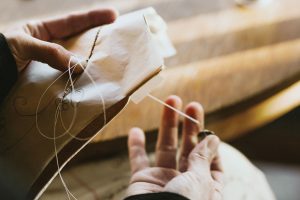Just three hours from Sun Valley, the Fort Hall Indian Reservation is home to the Shoshone-Bannock Tribes who have lived for centuries in the Intermountain West. And although the tribes’ history is deeply rooted in the region, the connection is sometimes lost between the Wood River Valley and the reservation. Sun Valley resident and Camas Design founder Elizabeth Bunce decided to do what she could to bridge part of that gap by celebrating artists and giving back.
Originally from Connecticut, Bunce moved to Sun Valley more than thirty years ago. The daughter of a textile designer and previously an interior architect, she has always had an eye for the beautiful, handmade, and historically significant. After an impromptu visit to the Fort Hall Indian Reservation, Bunce saw the intricate traditional beadwork on display in a boutique and a spark ignited.
“I thought, ‘Wouldn’t it be interesting if you could take these and make them into more modern, everyday designs using the traditional techniques?’” Bunce said. The idea for Camas Design took root. The name embodies her mission: Camas pays homage to the blue flowering native plant that can be found throughout the region. It is also historically important as a sustainable source of nourishment and trade for indigenous peoples of the region where Bunce has made her home.
Her business is based on collaborations with Native American artists and tanners to create sophisticated, handmade, and beaded leather clothing that honors both the tradition and the artist. The result: stunning wearable art.
But it wasn’t enough to help create the pieces. Bunce wanted Camas Design to be a launchpad for empowering artists; 75 percent of all profits are donated to the Institute of American Indian Arts Foundation. In light of the COVID-19 pandemic, the proceeds from one of Camas Design’s Navajo artists is now going to the Navajo Nation’s relief fund to support the deeply affected residents.
“My kids are all grown. I have the time. And I feel lucky that I am in a position to be able to do this,” said Bunce.
The New Mexico-based organization, founded in 2010, raises funds to empower students to succeed in their crafts.
“I was drawn to what IAIA [Institute of American Indian Arts] has enabled women to do,” Bunce said. “Beading might be something they learned from their grandmother, their mother, that’s gone back multiple generations in their community. It enables them to take a traditional craft, then go out into the world and make a living as an artist.”
The process begins with a custom order from a client, be it a color palette, idea, or concept. Bunce works with Allen Hood, a member of the Navajo Nation, for tanning.
“I buy nearly all of my hides from Allen,” Bunce said. “It is a complicated process and super physical. It takes two weeks to produce one tanned hide, and the hides are absolutely incredible and unlike any other leather.” Each hide is tanned deerskin.
Allen learned his skills from his brother-in-law and members of the Shoshone-Bannock Tribes. Allen acquires his raw materials in Burley and American Falls, Idaho, as well as Oregon and North Dakota.
After Bunce acquires the tanned hide, she works with a seamstress to create the patterns for the clothing. Although Bunce doesn’t have a background in sewing or pattern making, she has taught herself and is learning the process. After she receives the completed clothing, she then sends it to one of her artists to begin the intricate process of beading.

Each piece is hand-beaded by a Native American woman in the style passed down by elders.
“I like giving each artist as much freedom as possible to bead what they love,” Bunce said. “Every artist has their own style. Most of the time the style that they bead in is the style of their tribe—Navajos have a geometric pattern style; Plains Indians bead in a floral pattern. I find it interesting that it is very much a self-expression of who they are as a people.”
And while the designs themselves are eye-catching, the process behind the designs is just as compelling, requiring hours of incredibly complex attention to detail for each creation.
“When something is hand-beaded, like the Camas Design jackets, every single individual bead is sewn on and knotted,” she said. “It is such an intricate process.”
One of the biggest challenges over the years, Bunce said, has been building relationships. Although she initially wanted to only work with artisans within the region, she has forged relationships with talented women across North America, some of whom went to the Institute of American Indian Arts, bringing the process full circle.
Artist Nathalie Waldman, a member of the Dene Nation and the Dogrib Tribe, is based out of Sante Fe, N.M. She combines her urban Montreal influences with her heritage, creating stunning custom designs. Jamie Gentry, an artist in Vancouver Island, Wash., is a member of the Da’naxda’xw Nation and the Kwakwaka’wakw Tribe. Her work incorporates traditional teachings with a modern touch.
Camas Designs has a variety of styles and silhouettes, from jackets to lace-up moccasins. The maiden jackets are the original silhouette for the Camas collection featuring a longer style. A similar length and silhouette to the maiden jacket, the cruiser vest is another popular style. The swing jacket is a cropped vest look. This past Christmas, Bunce launched a new product: beaded jean jackets she calls the liberty jacket with simple, vibrant geometric or floral designs.
Whereas the leather jackets and vests are an investment into a piece of wearable art, the liberty jackets allow Bunce to offer apparel that features intricate beading but at a more approachable price for someone looking for more casual wear.


